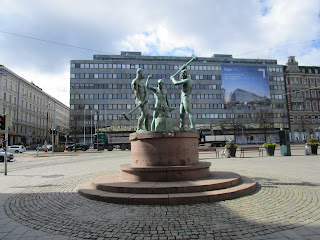 |
| The Three Blacksmiths of Helsinki, hanging out on Mannerheimintie |
At the end of Aleksanterinkatu, where it ends at the wide boulevard Mannerheimintie (named after Carl Gustaf Emil Mannerheim, who we will meet later up the street that bears his hame), across from the entrance to Stockmann's department store, is Kolme seppää, the Three Blacksmiths. The smiths are dressed for the sauna, pounding on an anvil for metaphorical reasons known only to the artist.
Why three? Why the anvil? Why the danger of blacksmithery while naked?
I don't think it's supposed to have any communist overtones, although that always is a possibility in this part of the world. I could be wrong. But the figures have too much life, too much movement, for this is to from that awful school of "socialist realism" art.
I believe this building is the Vanha Ylioppilastalo. Translation (and we know "vanha" means "old"): Old Student House.
It's now an events center.
This is Helsingin päärautatieasema, the Helsinki central train station.
This is architecture from a different era.
But which era? It's art deco, but it's neoclassical. And it's got giant statues paired on each side of the main entrance. If more train stations looked like this, we'd still be riding the rails.
This is the Kiasma, the museum of contemporary art. It is currently housing an exhibit of gay porn. Yes. The drawings of Tom of Finland. Who was Finnish, apparently. Who knew?
So it is appropriate.
And, outside the museum, strangely enough, is a statue of Carl Gustaf Emil Mannerheim.
Baron Mannerheim, as we like to call him, was an important military figure in the securing the independence of Finland at the end of World War I. He was the leader of the Finnish military during the Winter War, during which Finland somewhat successfully fought being re-absorbed into the Soviet Union (a fate that the Baltic Republics of Lithuania, Latvia, and Estonia could not escape) at the onset of World War II. I say "somewhat successfully" because it did lose territory to the USSR and Finland was forced to be a neutral who leaned heavily toward the interests of the USSR in matters of trade and foreign policy (a national emasculation called "Finlandization"). But they kept their independence, remained a liberal democracy, and did not descend into being a socialist hell-hole.
The next stop on the walk up Mannerheimintie is the Helsinki Music Centre. The building is boringly modern, but it does have this huge giant sculpture in front.
Laulupuut-veistos. Song Trees.
This is Pikkuparlamentti, the Finnish parliament building.
The name means "a small parliament." For a relatively small nation.
I'm underwhelmed. So many European countries have beautiful, ornate parliament buildings. Finland, known for its design, has a bland box with faux Greek columns that look like a third-rate building for some third-tier government agency in Washington, D.C. Not a winner.
Not even with these weird barren trees on the property. Or this statue of Kyösti Kallio, president of Finland during the early World War II years.
He is the only Finnish president to have died in office. He also was the first Finnish president to have resigned from the office. That was in a prior stint in the presidency. Chronologically, it would have been more appropriate to say that he became president, resigned, later returned to the presidency, then died in office.
Here he is seen with Finland's National Museum over his right shoulder (left side of the picture).
But that's for the next and final episode of my walking tour of Helsinki. At least the snowstorm -- technically a "snow flurry storm," I know -- has temporarily stopped.

















No comments:
Post a Comment